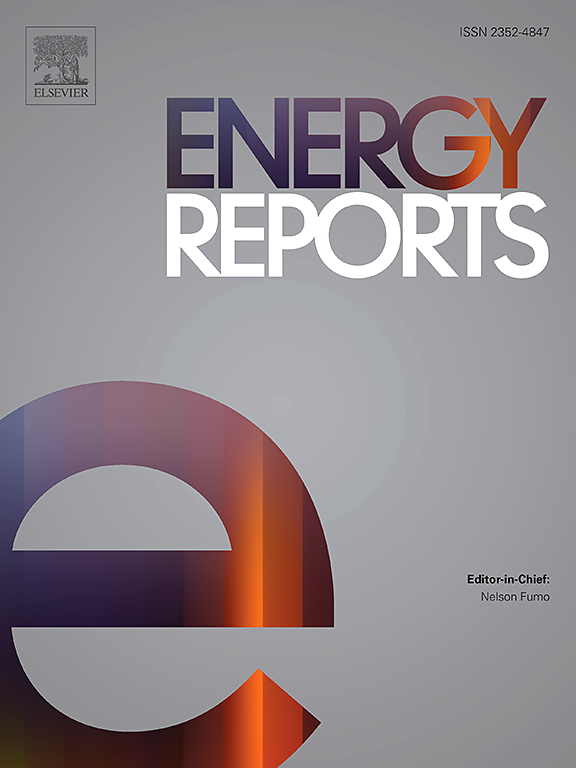Feedback action and genetic algorithm-based proportional-integral controller to improve the performance of the direct power control of a variable-speed contra-rotating wind turbine generation system
IF 4.7
3区 工程技术
Q2 ENERGY & FUELS
引用次数: 0
Abstract
An enhanced control scheme of a double-powered asynchronous generator (DPAG) integrated into a variable-speed contra-rotating wind turbine (VSCRWT) generation system is displayed in this paper. The original idea treated here is to develop a robust direct power control (DPC) using a new kind of proportional-integral (PI) regulator based on feedback command theory and genetic algorithm (GA) for the DPAG-VSCRWT system. The suggested feedback PI (FPI) controller based on the GA technique is designed to improve the performance and robustness of the DPC of the DPAG-VSCRWT system, especially the problem of low robustness. The DPC-FPI-GA strategy was applied to the machine inverter only, where the pulse width modulation (PWM) strategy was used to convert the reference voltage values generated by the FPI-GA controllers. Therefore, this strategy differs from the traditional DPC strategy in terms of principle, performance, durability, and effectiveness in improving the quality of current and energy. The DPC-FPI-GA approach with the PWM technique is applied to the VSCRWT system using a 1500 kW DPAG during various tests in MATLAB software. The characteristics of the presented DPC-FPI-GA approach with the PWM technique are verified by numerical simulations. The performances of the DPC-FPI-GA approach with the PWM technique are verified using performance indicators (such as the ripple ratio for torque, power, and current, as well as the harmonic distortion value of the current) and detailed discussions are given at the end of the paper. It was found that the proposed DPC-FPI-GA with PWM technique contributed significantly to the improvement of power quality produced by the DPAG-VSCRWT system even in the presence of internal and/or external disturbances. In addition, the designed DPC approach based on the PWM and FPI-GA techniques provides minimum harmonic distortion of current, reduces the ripples of the torque and energy, and enhances the time response of the DPAG-VSCRWT system.
基于反馈作用和遗传算法的比例积分控制器改善变速对转风力发电系统的直接功率控制性能
提出了一种将双功率异步发电机(DPAG)集成到变速对转风力发电系统中的改进控制方案。本文的原始思想是利用一种基于反馈指令理论和遗传算法的新型比例积分(PI)调节器为DPAG-VSCRWT系统开发鲁棒直接功率控制(DPC)。为了提高DPAG-VSCRWT系统的DPC控制器的性能和鲁棒性,特别是鲁棒性较低的问题,设计了基于遗传算法的反馈PI (FPI)控制器。DPC-FPI-GA策略仅应用于机器逆变器,其中脉冲宽度调制(PWM)策略用于转换由FPI-GA控制器产生的参考电压值。因此,该策略与传统的DPC策略在原理、性能、耐用性和提高电流和能量质量的有效性方面都有所不同。将DPC-FPI-GA方法与PWM技术应用于使用1500 kW DPAG的VSCRWT系统,并在MATLAB软件中进行了各种测试。数值仿真验证了采用PWM技术的DPC-FPI-GA方法的特性。通过性能指标(如转矩、功率和电流的纹波比以及电流的谐波失真值)验证了采用PWM技术的DPC-FPI-GA方法的性能,并在文章的最后进行了详细的讨论。研究发现,即使存在内部和/或外部干扰,所提出的DPC-FPI-GA与PWM技术也能显著改善DPAG-VSCRWT系统产生的电能质量。此外,基于PWM和FPI-GA技术设计的DPC方法提供了最小的电流谐波失真,减少了转矩和能量的波动,提高了DPAG-VSCRWT系统的时间响应。
本文章由计算机程序翻译,如有差异,请以英文原文为准。
求助全文
约1分钟内获得全文
求助全文
来源期刊

Energy Reports
Energy-General Energy
CiteScore
8.20
自引率
13.50%
发文量
2608
审稿时长
38 days
期刊介绍:
Energy Reports is a new online multidisciplinary open access journal which focuses on publishing new research in the area of Energy with a rapid review and publication time. Energy Reports will be open to direct submissions and also to submissions from other Elsevier Energy journals, whose Editors have determined that Energy Reports would be a better fit.
 求助内容:
求助内容: 应助结果提醒方式:
应助结果提醒方式:


